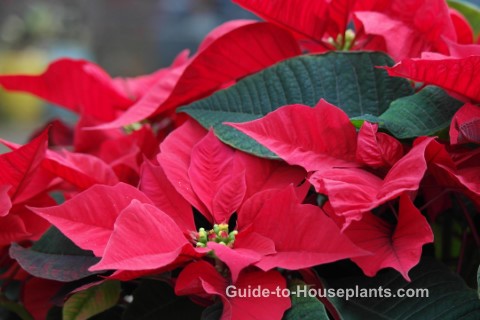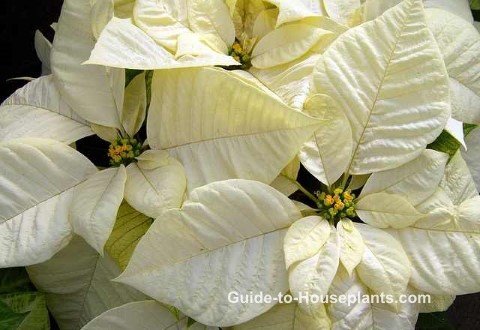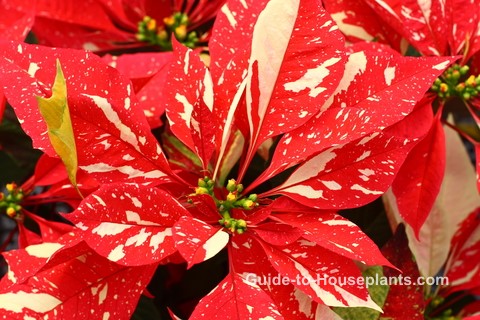Poinsettia Care Tips
Botanical Name: Euphorbia pulcherrima
Good poinsettia care will keep your plant beautiful right through the holidays. In this guide, you'll find out much water and light it wants year-round, plus how to make your poinsettia plant re-bloom next year.

Bright and cheery, poinsettia is the top-selling flowering plant in the U.S. and the most popular for decorating and gift-giving at Christmas time.
Its "flowers" are actually leaf-like bracts that surround the tiny, yellow true flowers in the center. Red still rules, but newer cultivars are available in burgundy, white, peach or pink -- some marbled or flecked. They also range from palm-sized miniatures to giant floor plants with bigger bracts than we've ever seen.
Buying Tips
There are more than 100 varieties of poinsettia, and the ones available change often as improved and novelty varieties are introduced. Choose whatever tickles your fancy -- just be sure you're getting a healthy plant. Here are some tips:
- Look for plants with small, unopened flower buds in the center of the bracts.
- Never buy a poinsettia that has been exposed to cold weather for any length of time.
- Cover with a plastic sleeve to keep it from being chilled on the way home.

Most poinsettias are tossed out after the holidays, or after the bracts have faded. However, with some effort and these poinsettia care tips, you can coax your poinsettia back into bloom before next Christmas.
How to Make Poinsettia Bloom Again
- When leaves start to fall, water sparingly (just enough to keep soil from drying out completely) and do not fertilize.
- In early April, prune the plant back to 6 in (15 cm) stems. This will stimulate new growth. Keep your poinsettia in a bright location with regular waterings and begin fertilizing. Once you see new growth, repot it in fresh soil.
- Poinsettia needs long nights and short days to bloom. Beginning in early October, give it 10 weeks of long nights (14 hours of complete darkness). Put a box over it, or put it in a closet, if you need to so that the plant gets uninterrupted darkness every night. Bring it out during the daytime and put it in a bright (indirect sun) location.
- Once the bracts begin to show color, resume with normal poinsettia care.

Poinsettia Care Problems, Solutions and Answers
Dropped leaves? Not enough sunlight and cold temperatures will cause leaves to fall off. Take care to cover your plant while taking it home from the store; even a short-time exposure to freezing temperatures will harm the plant.
Wilted leaves are a symptom of soggy soil. This tropical native likes humidity more than water. Allow the potting mix to dry out a bit before watering again, but don't allow poinsettia to dry out either.
Something bugging your poinsettia? Look over your plant for red spider mites that are attracted to plants in winter. They're so tiny, you'll likely notice their webbing first. Treat any infestation immediately to prevent pests from moving on to your other houseplants. Raising the humidity around your poinsettia plant can help prevent spider mites that prefer dry air.
Wondering whether to repot? Not needed unless you're keeping your poinsettia for another year. If you want to cover a plain nursery pot, slip it into a cachepot -- a decorative container without drainage holes. Cover the bottom of the cachepot with pebbles or small rocks to keep the inner pot above the drainage water.
Is poinsettia poisonous? Contrary to popular belief, poinsettia sap is not lethal, just irritating. According to the Mayo Clinic, eating poinsettia leaves may cause an upset stomach and mouth irritation. Contact with the leaves and sap may cause skin and eye irritation, so it's a good idea to wear gloves when handling it.
Poinsettia Care Tips

Height: Varies from 6 in (15 cm) miniatures to 36 in (90 cm) tall, full plants
Light: Poinsettia grows best in bright, indirect light. Some direct morning sun is fine, but hot direct midday sun can cause bract color to fade.
Water: Water thoroughly, then allow top of soil to dry out between waterings. Remove the decorative foil to allow good drainage. This plant is prone to root rot if soil is too soggy.
Humidity: Average room humidity (around 40% relative humidity). Indoor air can become extremely dry in winter; check out these easy ways to increase humidity for your tropical plants.
Temperature: Average room temperatures 60-75°F/15-24°C. It doesn't like cold drafts from doors and windows. Exposing it to temperatures below 50°F/10°C can cause its leaves to drop.
Soil: Peat moss based potting mix
Fertilizer: Not usually necessary, but if the poinsettia is kept for another season it will benefit from a high-phosphorus fertilizer diluted by half every 2 weeks.
Propagation: Take 3 in (7.5 cm) stem tip cuttings when new growth starts in spring or early summer. Cuttings will ooze a milky sap that can be stopped by placing the cut end in water before potting it.


